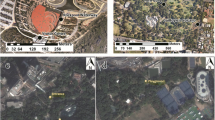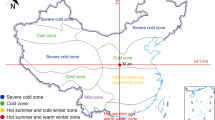Abstract
A variety of research has linked high temperature to outdoor thermal comfort in summer, but it remains unclear how outdoor meteorological environments influence people’s thermal sensation in subtropical monsoon climate areas, especially in China. In order to explain the process, and to better understand the related influential factors, we conducted an extensive survey of thermally comfortable conditions in open outdoor spaces. The goal of this study was to gain an insight into the subjects’ perspectives on weather variables and comfort levels, and determine the factors responsible for the varying human thermal comfort response in summer. These perceptions were then compared to actual ambient conditions. The database consists of surveys rated by 205 students trained from 6:00 am to 8:00 pm outdoors from 21 to 25 August 2009, at Nanjing University of Information Science & Technology (NUIST), Nanjing, China. The multiple regression approach and simple factor analysis of variance were used to investigate the relationships between thermal comfort and meteorological environment, taking into consideration individual mood, gender, level of regular exercise, and previous environmental experiences. It was found that males and females have similar perceptions of maximum temperature; in the most comfortable environment, mood appears to have a significant influence on thermal comfort, but the influence of mood diminishes as the meteorological environment becomes increasingly uncomfortable. In addition, the study confirms the strong relationship between thermal comfort and microclimatic conditions, including solar radiation, atmospheric pressure, maximum temperature, wind speed and relative humidity, ranked by importance. There are also strong effects of illness, clothing and exercise, all of which influence thermal comfort. We also find that their former place of residence influences people’s thermal comfort substantially by setting expectations. Finally, some relationships between thermal perception and amount of exercise, thermal experience, mood, clothing, illness and microclimate, etc., are established. Our findings also shed light on how to resist or adapt to outdoor hyperthermic conditions during summer in subtropical monsoon climate areas.




Similar content being viewed by others
References
Arens E, Bosselmann P (1989) Wind, sun and temperature-predicting the thermal comfort of people in outdoor spaces. Build Environ 24(3):315–320
Arens E, Gonzalez R, Berglund LG (1986) Thermal comfort under an extended range of environmental conditions. ASHRAE Trans 92(1):18–26
Baker N (1993) Comfort in passive buildings. In: Proceedings of Solar Energy and Buildings, Academy of Athens
Becker S, Potchter O, Yaakov Y (2003) Calculated and observed human thermal sensation in an extremely hot and dry climate. Energy Build 35:747–756
Berger X (2001) Human thermal comfort at Nîmes in summer heat. Energy Build 33:283–287
Chun C, Kwok A, Tamura A (2004) Thermal comfort in transitional spaces—basic concepts: literature review and trial measurement. Build Environ 39:1187–1192
Eliasson I, Knez I, Westerberg U et al (2007) Climate and behaviour in a Nordic city. Landscape Urban Plann 82:72–84
Fazia AT, Mayer H (2006) Numerical study on the effects of aspect ratio and orientation of an urban street canyon on outdoor thermal comfort in hot and dry climate. Build Environ 41:94–108
Givoni B, Noguchi M, Saaroni H et al (2003) Outdoor comfort research issues. Energy Build 35(1):77–86
Gonzalez RR, Gagge AP (1973) Magnitude estimates of thermal discomfort during transients of humidity and operative temperature, and their relation to the new ASHRAE effective temperature. ASHRAE Trans 79(1):88–96
Gonzalez RR, Nishi Y, Gagge AP (1974) Experimental evaluation of standard effective temperature—a new biometeorological index of Man's thermal discomfort. Int J Biometeorol 18(1):1–15
Höppe P (2002) Different aspects of assessing indoor and outdoor thermal comfort. Energy Build 34(6):661–665
Humphreys MA (1976) Field studies of thermal comfort compared and applied. Build Serv Eng 44:5–27
Huynen M, Martens P, Schram D et al (2001) The impact of heat waves and cold spells on mortality rates in the Dutch population. Environ Health Perspect 109:463–470
IPCC (2007) Summary for Policymakers. In: Solomon SD, Qin M, Manning Z, Chen M, Marquis KB, Averyt M, Tignor, Miller HL (eds) Climate Change 2007: The Physical Science Basis. Contribution of Working Group I to the Fourth Assessment Report of the Intergovernmental Panel on Climate Change. Cambridge University Press, Cambridge
Kalkstein LS (1993) Health and climate change: direct impact impacts in cities. Lancet 342:1397–1399
Kalkstein LS, Greene JS (1997) An evaluation of climate/mortality relationships in large US cities and the possible impacts of a climate change. Environ Health Perspect 105:84–93
Kalkstein LS, Smoyer KE (1993) The impact of climate change on human health: some international implications. Experientia 49:969–979
Keatinge WR, Donaldson GC, Cordioli E et al (2000) Heat related mortality in warm and cold regions of Europe: observational study. BMJ 321:670–673
Li F, Lu D (1997) Features of aerosol optical depth with visibility grade over Beijing. Atmos Environ 31(20):3413–3419
Lin TP (2009) Thermal perception, adaptation and attendance in a public square in hot and humid regions. Build Environ 44:2017–2026
Lin TP, Matzarakis A, Hwang RL (2010) Shading effect on long-term outdoor thermal comfort. Build Environ 45:213–221
Martonchik JV, Ding DJ et al (1998) Techniques for the retrieval of aerosol properties over land and ocean using multi-angle imaging. IEEE Trans Geosci Remote Sens 16(4):1212–1227
Metje N, Sterling M, Baker CJ (2008) Pedestrian comfort using clothing values and body temperatures. J Wind Eng Ind Aerodyn 96(4):412–435
Nikolopoulou M, Lykoudis S (2006) Thermal comfort in outdoor urban spaces: analysis across different European countries. Build Environ 41:1455–1470
Nikolopoulou M, Steemers K (2003) Thermal comfort and psychological adaptation as a guide for designing urban spaces. Energy Build 35(1):95–101
Nikolopoulou M, Baker N, Steemers K (2001) Thermal comfort in outdoor urban spaces: understanding the human parameter. Solar Energy 70:227–235
Pearlmutter D, Bitan A, Berliner P (1999) Microclimatic analysis of “compact” urban canyons in an arid zone. Atmos Environ 33:4143–4150
Qiu JH, Yang LQ (2000) Variation characteristics of atmospheric aerosol optical depths and visibility in North China during 1980–1994. Atmos Environ 34(4):603–609
Semenza JC, Rubin CH, Falter KH et al (1996) Heat-related deaths during the July 1995 heat wave in Chicago. N Engl J Med 335(2):84–90
Sheridan SC, Kalkstein LS (2004) Progress in heat watch–warning system technology. Bull Am Meteorol Soc 85:1931–1941
Spagnolo J, de Dear R (2003) A field study of thermal comfort in outdoor and semi-outdoor environments in subtropical Sydney Australia. Build Environ 38:721–738
Stathopoulos T, Wu H, Zacharias J (2004) Outdoor human comfort in an urban climate. Build Environ 39:297–305
Tan J, Zheng Y, Song G et al (2007) Heat wave impacts on mortality in Shanghai, 1998 and 2003. Int J Biometeorol 51:193–200
Tan J, Zheng Y, Tang X et al (2010) The urban heat island and its impact on heat waves and human health in Shanghai. Int J Biometeorol 54(1):75–84
Thorsson S, Lindqvist M, Lindqvist S (2004) Thermal bioclimatic conditions and patterns of behaviour in an urban park in Göteborg. Sweden Int J Biometeorol 48:149–256
Thorsson S, Honjo T, Lindberg F et al (2007) Thermal comfort and outdoor activity in Japanese urban public places. Environ Behav 39:660–684
Zheng YF, Yin JF, Wu RJ et al (2010) Applicability of universal thermal climate index to thermal comfort forecast (in Chinese). J Appl Meteorol Sci 21(6):709–715
Acknowledgments
The authors would like to thank Key Projects in the National Science & Technology Pillar Program during the Eleventh Five-Year Plan Period (2007BAC29B05) and Jiangsu Key Laboratory of Meteorological Disaster (KLME05005) for financial support for this research. Two anonymous reviewers are thanked for their comments on an earlier version of the manuscript. We also thank two native English speakers from Canada, Dr. D.S. van der Zwaag, Jr. and Dr. N. Zhamangulova, for their further review of this document.
Author information
Authors and Affiliations
Corresponding author
Appendix. Thermal comfort questionnaire
Appendix. Thermal comfort questionnaire

Rights and permissions
About this article
Cite this article
Yin, J., Zheng, Y., Wu, R. et al. An analysis of influential factors on outdoor thermal comfort in summer. Int J Biometeorol 56, 941–948 (2012). https://doi.org/10.1007/s00484-011-0503-9
Received:
Revised:
Accepted:
Published:
Issue Date:
DOI: https://doi.org/10.1007/s00484-011-0503-9




